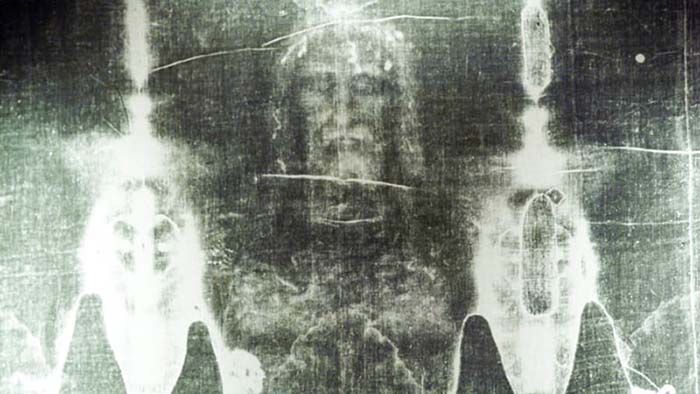


Shroud of Turin wasn't laid on Jesus' body, but rather a sculpture, modeling study suggests Live Science - August 1, 2025
A 3D analysis comparing the way fabric falls on a human body versus a low-relief sculpture shows that the Shroud of Turin was not based on a real person. The Shroud of Turin, famously claimed to be Jesus' original burial covering, could not have been created on a three-dimensional human body, a new study finds. It is much more likely that the image is an imprint of a low-relief sculpture, according to a graphics expert.
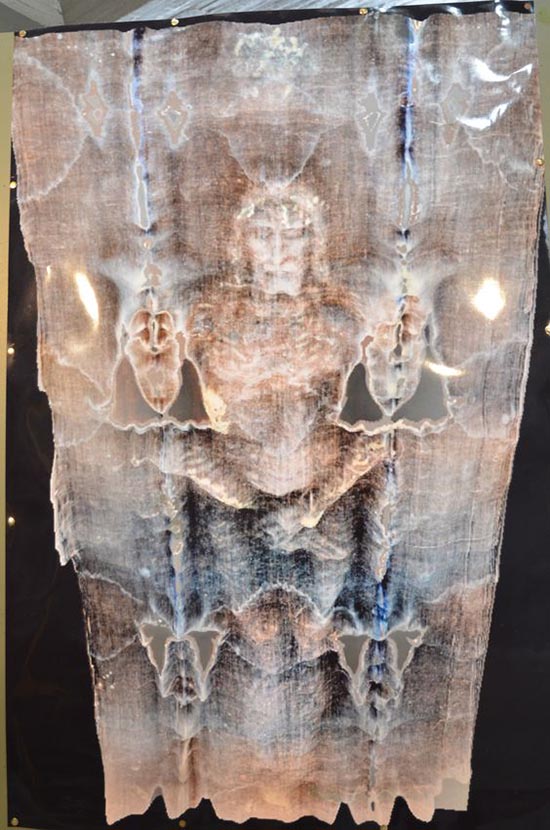
Shroud of Turin
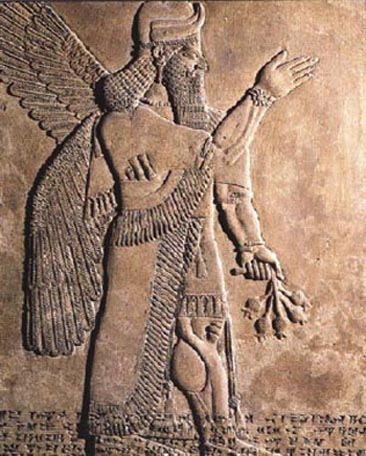
Is Jesus wearing an Anunnaki wrist device (teleportation, communication, creation, simulation manipulation, more) which makes him part of Zoroaster's bloodline - or are they one and the same soul in different roles and timelines? Are they who we envision as extraterrestrial?
I never believed the story of the shroud nor do I believe in religion. Just more busy work to deflect from the fact that we live in a simulation. As for the wrist device - coincidence and yet we know there are no coincidences.
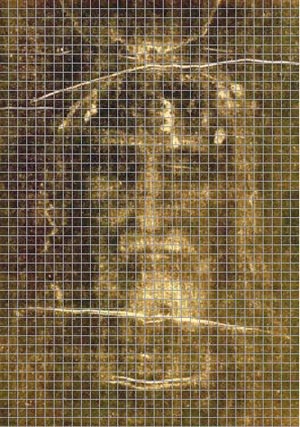
The Shroud of Turin (or Turin Shroud) is an ancient linen cloth bearing the image of a man who appears to have been physically traumatized in a manner consistent with crucifixion. It is presently kept in the royal chapel of the Cathedral of Saint John the Baptist in Turin, Italy.
Some believe it is the cloth that covered Jesus of Nazareth when he was placed in his tomb and that his image was somehow recorded on its fibers at or near the time of his proclaimed resurrection. Skeptics contend the shroud is a medieval hoax or forgery - or even a devotional work of artistic verisimilitude. It is the subject of intense debate among some scientists, believers, historians and writers regarding where, when and how the shroud and its images were created.
Arguments and evidence cited against a miraculous origin of the shroud images include a letter from a medieval bishop to the Avignon pope claiming personal knowledge that the image was cleverly painted to gain money from pilgrims; radiocarbon tests in 1988 that yielded a medieval timeframe for the cloth's fabrication; and analysis of the image by microscopist Walter McCrone, who concluded ordinary pigments were used.
Arguments and evidence cited for the shroud's being something other than a medieval forgery include textile and material analysis pointing to a 1st-century origin; the unusual properties of the image itself which some claim could not have been produced by any image forming technique known before the 19th century; objective indications that the 1988 radiocarbon dating was invalid due to improper testing technique; and repeated peer-reviewed analyses of the image mode which contradict McCrone's assertions. Also, pollen from many places the shroud was said to have gone through are found, such as pollen from plants that exist only in certain areas near Jerusalem.
Both skeptics and proponents tend to have entrenched positions on the cause of formation of the shroud image, which has made dialogue very difficult. This may prevent the issue from ever being fully settled to the satisfaction of all sides.
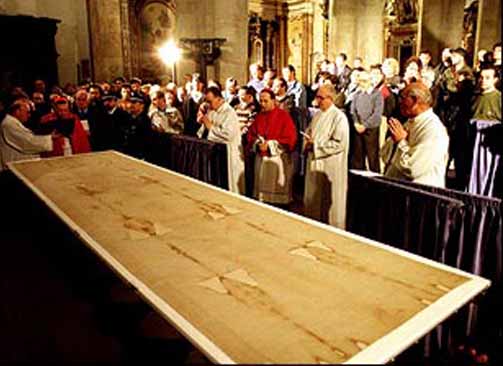
�The shroud is rectangular, measuring approximately 4.4 x 1.1 m (14.3 x 3.7 ft). The cloth is woven in a herringbone twill and is composed of flax fibrils entwined with cotton fibrils. It bears the image of a front and dorsal view of a naked man with his hands folded across his groin. The two views are aligned along the midplane of the body and pointing in opposite directions. The front and back views of the head nearly meet at the middle of the cloth. The views are consistent with an orthographic projection of a human body.
The "Man of the Shroud" has a beard, moustache, and shoulder-length hair parted in the middle. He is well-proportioned and muscular, and quite tall (1.75 m or roughly 5 ft 9 in) for a man of the first century (the time of Jesus' death) or for the Middle Ages (the time of the first uncontested report of the shroud's existence, and the proposed time of possible forgery). Dark red stains, either blood or a substance meant to be perceived as blood, are found on the cloth, showing various wounds:
on at least one wrist, apparently by piercing. (The second wrist is hidden behind the first.)
on his side, apparently from piercing
around his forehead
scores of times on his torso and legs, apparently from scourging
At approximately 175 cm (5' 9"), the physical stature of the man is quite large - both for the 1st century, the time the shroud is purported to be from, and for the Middle Ages, the time of its purported fabrication.
On May 28, 1898 an amateur Italian photographer, Secondo Pia, photographed the shroud and was startled by the resulting undeveloped negative. The negative gave the appearance of a positive image, seemingly indicating that the shroud image itself is a negative (perhaps, wondered the faithful, produced upon the cloth by some luminous event at the moment of resurrection?).
The detail and heft of the man on the shroud was greatly enhanced in the photographic negative, leading to renewed speculation on its miraculous origin. The realistically rendered three-dimensionality of the man and his anatomically perfect depiction have inspired believers and fascinated critics, for no known artist, ancient, medieval or even later up to the advent of photography, approached this degree of fidelity to life, with the possible exception of a few ancient Greek and Italian renaissance sculptors. Even then, the transference of the image of a masterwork sculpture or a human model onto a flat surface while retaining its three-dimensional characteristics seems beyond any pre-20th-century process.
Reports of Jesus's burial shroud have been circulating since the 14th century, and attempts have been made since then to connect the "Shroud of Turin" with the "Image of Edessa" though no connection can be substantiated. The 10th-century image shows Abgarus of Edessa displaying the Image of Edessa. The oblong cloth shown here is unusual for depictions of the image, leading some to suggest that the artist was influenced by seeing the Shroud.
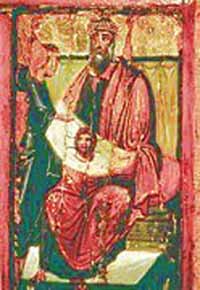
There are numerous reports of Jesus' burial shroud, or an image of his head, of unknown origin, being venerated in various locations before the fourteenth century. However, none of these reports has been connected with certainty to the current cloth held in the Turin cathedral. Except for the Image of Edessa, none of the reports of these (up to 43) different "true shrouds" was known to mention an image of a body.
The Image of Edessa was reported to contain the image of the face of Christ, and its existence is reported reliably since the sixth century. Some have suggested a connection between the Shroud of Turin and the Image of Edessa. No legend connected with that image suggests that it contained the image of a beaten and bloody Jesus, but rather it was said to be an image transferred by Jesus to the cloth in life. This image is generally described as depicting only the face of Jesus, not the entire body.
Proponents of the theory that the Edessa image was actually the shroud, led by Ian Wilson, theorize that it was always folded in such a way as to show only the face.Three principal pieces of evidence are cited in favor of the identification with the shroud. John Damascene mentions the image in his anti-iconoclastic work On Holy Images, describing the Edessa image as being a "strip", or oblong cloth, rather than a square, as other accounts of the Edessa cloth hold.
On the occasion of the transfer of the cloth to Constantinople in 944, Gregory Referendarius, archdeacon of Hagia Sophia in Constantinople, held a sermon about the artifact. This sermon had been lost, but was rediscovered in the Vatican Archives and translated by Mark Guscin in 2004. This sermon says that this Edessa Cloth contained not only the face, but a full-length image, which was believed to be of Jesus. The sermon also mentions bloodstains from a wound in the side.
Other documents have since been found in the Vatican library and the University of Leiden, Netherlands, confirming this impression. "Non tantum faciei figuram sed totius corporis figuram cernere poteris" (You can see not only the figure of a face, but [also] the figure of the whole body). (In Italian) (Cf. Codex Vossianus Latinus Q69 and Vatican Library Codex 5696, p. 35.)
In 1203, a Crusader Knight named Robert de Clari claims to have seen the cloth in Constantinople: "Where there was the Shroud in which our Lord had been wrapped, which every Friday raised itself upright so one could see the figure of our Lord on it." After the Fourth Crusade, in 1205, the following letter was sent by Theodore Angelos, a nephew of one of three Byzantine Emperors who were deposed during the Fourth Crusade, to Pope Innocent III protesting the attack on the capital. From the document, dated 1 August 1205: "The Venetians partitioned the treasures of gold, silver, and ivory while the French did the same with the relics of the saints and the most sacred of all, the linen in which our Lord Jesus Christ was wrapped after his death and before the resurrection.
We know that the sacred objects are preserved by their predators in Venice, in France, and in other places, the sacred linen in Athens." (Codex Chartularium Culisanense, fol. CXXVI (copia), National Library Palermo) Unless it is the Shroud of Turin, then the location of the Image of Edessa since the 13th century is unknown.Some historians speculate that the shroud may have been found in Constantinople by the Knights Templar during the 12th or 13th century and subsequentially taken to France. This could have been a major part of the famed 'Templar treasure' that treasure hunters still seek today.
The known provenance of the cloth now stored in Turin dates to 1357, when the widow of the French knight Geoffroi de Charny had it displayed in a church at Lirey, France (diocese of Troyes). In the Museum Cluny in Paris, the coats of arms of this knight and his widow can be seen on a pilgrim medallion, which also shows an image of the Shroud of Turin.
During the fourteenth century, the shroud was often publicly exposed, though not continuously, since the bishop of Troyes, Henri de Poitiers, had prohibited veneration of the image. Thirty-two years after this pronouncement, the image was displayed again, and King Charles VI of France ordered its removal to Troyes, citing the impropriety of the image.
The sheriffs were unable to carry out the order.In 1389 the image was denounced as a fraud by Bishop Pierre D'Arcis in a letter to the Avignon pope, mentioning that the image had previously been denounced by his predecessor Henri de Poitiers, who had been concerned that no such image was mentioned in scripture. Bishop D'Arcis continued, "Eventually, after diligent inquiry and examination, he discovered how the said cloth had been cunningly painted, the truth being attested by the artist who had painted it, to wit, that it was a work of human skill and not miraculously wrought or bestowed." (In German.) The artist is not named in the letter.
The letter of Bishop D'Arcis also mentions Bishop Henri's attempt to suppress veneration, but notes that the cloth was quickly hidden "for 35 years or so", thus agreeing with the historical details already established above. The letter provides an accurate description of the cloth: "upon which by a clever sleight of hand was depicted the twofold image of one man, that is to say, the back and the front, he falsely declaring and pretending that this was the actual shroud in which our Saviour Jesus Christ was enfolded in the tomb, and upon which the whole likeness of the Saviour had remained thus impressed together with the wounds which He bore."If the claims of this testimony are correct, it would be consistent with the radiocarbon dating of the shroud (see below). From the point of view of many skeptics, it is one of the strongest pieces of evidence that the shroud is a forgery.
Despite the pronouncement of Bishop D'Arcis, Antipope Clement VII (first antipope of the Western Schism) prescribed indulgences for pilgrimages to the shroud, so that veneration continued, though the shroud was not permitted to be styled the "True Shroud".
In 1418, Humbert of Villersexel, Count de la Roche, Lord of Saint-Hippolyte-sur-Doubs, moved the shroud to his castle at Montfort, France to provide protection against criminal bands, after he married Charny's granddaughter. It was later moved to Saint-Hippolyte-sur-Doubs. After Humbert's death, canons of Lirey fought through the courts to force the widow to return the cloth, but the parliament of Dole and the Court of Besancon left it to the widow, who travelled with the shroud to various expositions, notably in Liege and Geneva.
The widow sold the image in exchange for a castle in Varambon, France in 1453. Louis of Savoy, the new owner, stored it in his capital at Chambery in the newly built Saint-Chapelle, which Pope Paul II shortly thereafter raised to the dignity of a collegiate church. In 1464, the duke agreed to pay an annual fee to the Lirey canons in exchange for their dropping claims of ownership of the cloth. Beginning in 1471, the shroud was moved between many cities of Europe, being housed briefly in Vercelli, Turin, Ivrea, Susa, Chambery, Avigliano, Rivoli and Pinerolo. A description of the cloth by two sacristans of the Sainte-Chapelle from around this time noted that it was stored in a reliquary: "enveloped in a red silk drape, and kept in a case covered with crimson velours, decorated with silver-gilt nails, and locked with a golden key".
In 1532 the shroud suffered damage from a fire in the chapel where it was stored. A drop of molten silver from the reliquary produced a symmetrically placed mark through the layers of the folded cloth. Poor Clare Nuns attempted to repair this damage with patches. Some have suggested that there was also water damage from the extinguishing of the fire.
In 1578 the shroud arrived again at its current location in Turin. It was the property of the House of Savoy until 1983, when it was given to the Holy See.
In 1988 the Shroud was independently examined by Oxford University, the University of Arizona, and the Swiss Federal Institute of Technology. Using the technique of radiocarbon dating, they all agreed that the cloth dated to the 13th or 14th century (1260 to 1390).
However, some argue that the results may have been distorted by such factors as the fire of 1532, bacteria and bacterial residue that would not have been cleaned by the testing team's methods, or even neutrons released at the time of the Resurrection.
The bacterial "bioplastic coating" argument is the strongest, as there have been cases in which ancient textiles have yielded radiocarbon dates much younger than other artifacts in the same sites—most notably in the instance of mummy 1770 in the British Museum, whose bones dated 800 to 1,000 years older, according to the radiocarbon tests, than the textile in which they were wrapped. The portion of the shroud used for the radiocarbon dating was from a corner, which would have been handled often, increasing the likelihood of contamination. Bacteria and bacterial residue carry additional carbon and would skew the radiocarbon date toward the present.
This theory gained considerable force when Harry E. Gove, the nuclear physicist at the University of Rochester who designed the carbon-dating technique used on the shroud, stated, 'There is a bioplastic coating on some threads, maybe most.' If the coating is of a great enough thickness, according to Gove, it "would make the fabric sample seem younger than it should be" to the radiocarbon method. Skeptics have countered that, to shift the date by thirteen centuries, the contamination would have had to weigh twice as much as the entire Shroud.
The latest research has investigated the implications of the burn holes and water marks. The shroud was damaged in 1532 by a fire in the Chapel of Chambery Castle, in France, where it was kept before being brought to Turin. The burn marks date from that time and it was believed that this was also when it was damaged by being dowsed with water. However, a fabrics historian has now suggested that the water damage occurred earlier, since the pattern indicates that the cloth would have been folded in the same way as treasured fabrics that were kept in clay jars, like the Dead Sea Scrolls. These date from the 1st century AD, around the time of Jesus, which may indicate that the shroud is of a similar age.
Another piece of evidence fits this theory. A seam in the cloth is of a particular type that has only ever been seen in fabric from the fortress of Masada near the Dead Sea, which dated from the same period. Also, the weaving pattern and size of the cloth are consistent with 1st century Syrian design. Master textile restorer Mechthild Flury-Lemberg of Hamburg, Germany states, "The linen cloth of the Shroud of Turin does not display any weaving or sewing techniques which would speak against its origin as a high quality product of the textile workers of the 1st century."
Avinoam Danin of the Hebrew University of Jerusalem claimed to have identified pollen grains originating from around Jerusalem. Danin also compared the Shroud with the Sudarium of Oviedo, which has a detailed provenance to the 1st century, determining from the pattern of blood-colored stains that they could have both covered the same head.
The piercing of the wrists, rather than the palms, is not consistent with most medieval depictions of the crucifixion. However, it has been conjectured by Dr. Frederick Zugibe, a noted shroud researcher, that the nails may have been hammered in on an angle, entering in the palm, and exiting in the wrist. This would have tended to better support the body, and would explain the apparent contradiction with the traditional conception that the nails were "in the palm".
Whether the red-tinged stains on the shroud are actually blood has been questioned. Chemist Walter McCrone identified the substance as a combination of red ochre and vermilion tempera paint; others have specifically identified it as type AB blood, with no evidence of any artificial pigments. Only fibrils lifted from the shroud on sticky tape were tested for blood. Skeptics point out that the color is still an unfaded red, which would be expected of tempera paint but not of real blood.
Through the use of microscopy, it has been determined that the image is a result of discoloration of only the outermost fibers of the fabric, which suggests that the image may have been created through a radiative process. Painting appears to be ruled out.
Digital image processing Even more remarkable features are said to be noticeable when the image is digitally processed (although such claims are highly criticized).
Coins placed on both eyes, the right one identified as a type of Roman copper coins produced in 29 and 30 AD in Jerusalem. In 1997, Andre Marion and Anne-Laure Courage claimed to be able to make out Greek and Latin letters near the right side of the face.
In 2004, researchers from the University of Padua announced the discovery of a very faint and much less detailed image on the reverse side of the shroud, consisting of the face and hands. No details from the dorsal view are evident. Like the image on the obverse side, the newly discovered image is also the result of discoloration of only the outermost fibers of the fabric, and its features are aligned precisely with the features in the image on the obverse side. The discovery is the result of sophisticated processing of photographs taken in 2002, when the reverse side was exposed during the restoration.
Many Protestants contend that evidence the shroud is a hoax may be found in the Gospel of John in which the Christian biblical narrative identifies the wrappings of Jesus as two separate objects: "Then cometh Simon Peter following him, and went into the sepulchre, and seeth the linen clothes lie, And the napkin, that was about his head, not lying with the linen clothes, but wrapped together in a place by itself" (John 20:6, 7; King James Version).
Skeptics have proposed many means for producing the image in the Middle Ages. Lynn Picknett and Clive Prince (1994) proposed that the shroud is perhaps the first ever example of photography, showing the portrait of its alleged maker, Leonardo da Vinci.
According to this theory, the image was made with the aid of a magic lantern, a simple projecting device, or by means of a camera obscura and light-sensitive silver compounds applied to the cloth. However, Leonardo was born a century after the first documented appearance of the cloth. Supporters of this theory thus propose that the original cloth was a poor fake, for which Leonardo's superior hoax was substituted, though no contemporaneous reports indicate a sudden change in the quality of the image.
However, the resemblance between the shroud image and Leonardo's famous self-portrait has been described as striking by many. In addition to the similarity between the self-portrait, and the shroud image, the Turin Library, which houses the shroud, also contains the only known self-portrait of Leonardo in this manner.
Leonardo was widely known as a man with a sense of humor, and could very well have instilled his own image onto the shroud (whether authentic or otherwise). It is also a theory that he was commissioned by the royal family, with whom he was friends, to have done this to bring back to Turin what was lost from them so many years prior to this. It should be noted that Picknett and Prince's theories, appealing as they are to the imagination, are not taken seriously by most academic scholars. The notion proposed by them that Leonardo was a non-Christian heretic or pagan is similarly rejected by historians.
In 1977, a team of scientists selected by the Holy Shroud Guild developed a program of tests to conduct on the Shroud, designated the Shroud of Turin Research Project (STURP). Cardinal Ballestrero, the archbishop of Turin, granted permission, despite disagreement within the Church. The STURP scientists conducted their testing over five days in 1978. Walter McCrone, a member of the team, upon analyzing the samples he had, concluded in 1979 that the image is actually made up of billions of submicron pigment particles.
The only fibrils that had been made available for testing of the stains were those that remained affixed to custom-designed adhesive-backed tape applied to thirty-two different sections of the image. (This was done in order to avoid damaging the cloth.) According to McCrone, the pigments used were a combination of red ochre and vermilion tempera paint. The Electron Optics Group of McCrone Associates published the results of these studies in five articles in peer-reviewed journals: Microscope 1980, 28, 105, 115; 1981, 29, 19; Wiener Berichte uber Naturwissenschaft in der Kunst 1987/1988, 4/5, 50 and Acc. Chem. Res. 1990, 23, 77-83. STURP, upon learning of his findings, confiscated McCrone's samples and brought in other scientists to replace him. In McCrone's words, he was "drummed out" of STURP, and continued to defend the analysis he had performed, becoming a prominent proponent of the position that the Shroud is a forgery. As of 2004, no other scientists have confirmed McCrone's results with independent experiments.
Other microscopic analysis of the fibers seems to indicate that the image is strictly limited to the carbohydrate layer, with no additional layer of pigment visible. Proponents of the position that the Shroud is authentic say that no known technique for hand-application of paint could apply a pigment with the necessary degree of control on such a nano-scale fibrillar surface plane.
In the program "Decoding The Past: The Shroud of Turin", The History Channel reported the official finding of STURP that no pigments were found in the shroud image, and multiple scientists asserted this conclusion on camera. No hint of controversy over this claim was suggested. The program stated that a NASA scientist organized STURP in 1976 (after being surprised to find depth-dimensional information encoded within the shroud image); no mention of the Holy Shroud Guild was made.
In March 2005 Nathan Wilson, an instructor at New Saint Andrews College and amateur sindonologist, announced in an informal article in Books and Culture magazine that he had made a near-duplicate of the shroud image by exposing dark linen to the sun for ten days under a sheet of glass on which a positive mask had been painted. His method, though admittedly crude and preliminary, has nonetheless attracted the attention of several sindonologists, notably the late Dr. Raymond Rogers of the original STURP team, and Dr. Antonio Lombatti, founder of the skeptical shroud journal Approfondimento Sindone. Wilson's method is notable because it does not require any conjectures about unknown medieval technologies, and is compatible with claims that there is no pigment on the cloth. However, the experiment has not been repeated and the images have yet to face microscopic and chemical analyses. In addition, concerns have been raised about the availability or affordability of medieval glass large enough to produce the image, and the method's compatibility with Fanti's claim that the original image is doubly superficial.
Another theory suggests that the Shroud may have been formed using a bas-relief sculpture. Researcher Jacques di Costanzo, noting that the Shroud image seems to have a three-dimensional quality, suggested that perhaps the image was formed using an actual three-dimensional object, like a sculpture. While wrapping a cloth around full life-sized statue would result in a distorted image, placing a cloth over a bas-relief would result in an image like the one seen on the shroud. To demonstrate the plausibility of his theory, Constanzo constructed a bas-relief of a Jesus-like face and draped a wet linen over the bas-relief. After the linen dried, he dabbed it with ferric oxide and gelatine mixture. The result was image similar to that of the Shroud. Similar results have been obtained by author Joe Nickell. Instead of painting, the bas-relief could also be heated and used to burn an image into the cloth.
During restoration in 2002, the back side of the cloth was photographed and scanned for the first time. The journal of the Institute of Physics in London published a peer-reviewed article on this subject on April 14, 2004. Giulio Fanti and Roberto Maggiolo of the University of Padua, Italy, are the authors. They describe an image on the reverse side, much fainter than that on the other side, consisting primarily of the face and hands. Like the front image, it is entirely superficial, with coloration limited to the carbohydrate layer. The images correspond to, and are in registration with, those on the other side of the cloth. No image is detectable in the dorsal view section of the shroud.Supporters of the Maillard reaction theory point out that the gases would have been less likely to penetrate the entire cloth on the dorsal side, since the body would have been laid on a stone shelf. At the same time, the second image makes the photographic theory somewhat less probable (in addition to the fact that the image itself makes the photographic theory impossible.)
Does all this add up to definite answers on the origins of the Shroud of Turin? The question remains open until the authorities allow further dating tests to be done. However, for Christians, who state that their faith is independent of the authenticity of any relic, the results of the research would be irrelevant for their faith. Moreover, many believe the marks on this piece of linen to be a miraculous image of Jesus Christ, or at least something comparable to an icon, so its veneration need not diminish. <
In 2010, professors of statistics Marco Riani and Anthony C. Atkinson wrote in a scientific paper that the statistical analysis of the raw dates obtained from the three laboratories for the radiocarbon test suggests the presence of an important contamination in the samples.
A team of graphic artists tried to recreate the real face of Jesus in a special two-hour documentary on the History Channel broadcast for the first time in March 2010. The image was made by taking information and blood encoded on the Turin Shroud and transforming it into a 3D image.
The Shroud was placed back on public display (the 18th time in its history) in Turin from 10 April to 23 May 2010. According to Church officials, more than 2 million visitors came to see the Shroud.
In December 2010 Professor Timothy Jull, editor of Radiocarbon, coauthored an article with a textile expert in this peer-reviewed journal. They analyzed an unknown sample of 1988 and concluded that they found no evidence of a repair. However this article was strongly criticized, even by traditional skeptics.
In November 2011, F. Curciarello et al. published a paper that analyzed the abrupt changes in the yellowed fibril density values on the Shroud image. They concluded that the rapid changes in the body image intensity are not anomalies in the manufacturing process of the linen but that they can be explained with the presence of aromas and/or burial ointments. The paper also states that this consistent with the observation that based on the stochastic distribution of yellowed fibrils the image is not the work of an artist, and may have been formed over several decades. However, their work leaves the existence of an energy source for the image an open question.
In December 2011 scientists at Italy's National Agency for New Technologies, Energy and Sustainable Development ENEA announced that their series of tests demonstrated the image on the shroud could, in their opinion, only have been created by "some form of electromagnetic energy" such as a flash of light at short wavelength.
Professor Paolo Di Lazzaro, the lead researcher, indicated in an e-mail interview that " ... it appears unlikely a forger may have done this image with technologies available in the Middle Ages or earlier', but their study does not mean the Shroud image could only have been created by the flash of a miraculous resurrection, contrary to how the story was presented in the media, especially on the Web. Prominent skeptic Joe Nickell, however, is not impressed with the news. He indicates the latest findings is nothing new despite being 'dressed up in high-tech tests' and doesn't prove much of anything.
In December 2011 physicist Giulio Fanti published a critical compendium of the major hypotheses regarding the formation of the body image on the shroud. Fanti stated that "none of them can completely explain the mysterious image". Fanti then considered corona discharge as the most probable hypothesis regarding the formation of the body image. Read more ...